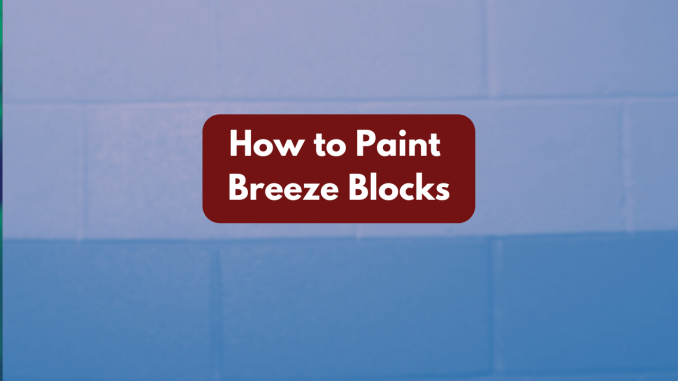
Learn how to paint a breeze block effectively and ensure it looks amazing first time around. You don’t want to be painting breeze blocks repeatedly and this step-by-step guide will help you paint a breeze block without going wrong.
What is a breeze block?
A breeze block, also known as a concrete block or cinder block is a rectangular construction material commonly used in building walls, partitions, and other structural elements. It is made from a mixture of cement, sand, and gravel or crushed stone, which are moulded into a block shape and then cured to achieve the desired strength.
Breeze blocks have hollow cores, which reduce their overall weight and make them easier to handle during construction. These hollow cores also allow for better insulation and can be filled with concrete or other materials for added strength and stability.
Breeze blocks are popular in construction due to their versatility, low cost, and ease of use. They are commonly used in both residential and commercial buildings for non-load-bearing walls, garden walls, retaining walls, and various other applications. Additionally, their textured and decorative patterns often give them an aesthetic appeal, making them a preferred choice in modern architectural designs.
Why are breeze blocks difficult to paint?
Breeze blocks can be difficult to paint for a few reasons:
Porous surface – Breeze blocks have a porous surface due to the nature of the materials used in their construction. This porosity allows the blocks to absorb moisture, which can cause paint to be absorbed unevenly and result in a patchy appearance.
Uneven texture – Similar to painting plasterboard, the textured surface of breeze blocks can be uneven, with various nooks and crannies, which makes it challenging to apply paint evenly. The paint may not reach all the crevices, leading to an uneven finish.
Dust and debris – Breeze blocks may accumulate dust and debris, which can affect the adhesion of the paint. If not properly cleaned before painting, the paint may not stick well to the surface, leading to peeling or flaking over time.
Efflorescence – Efflorescence is a phenomenon where soluble salts present in the breeze blocks migrate to the surface as water evaporates. These salts can cause discoloration and interfere with paint adhesion, making it difficult for the paint to adhere properly.
Coating thickness – Achieving a consistent and even coating thickness can be challenging on the textured surface of breeze blocks. Uneven paint thickness can result in an inconsistent appearance and compromise the overall aesthetic of the painted surface.
The best way to paint a breeze block
To overcome these challenges and achieve a fantastic result when painting breeze blocks, it is essential to take certain precautions and use the appropriate techniques:
Step 1: Prepare the surface
- Start by cleaning the breeze block surface thoroughly to remove dirt, dust, and any other contaminants. If available, use a scrub brush or pressure washer to clean the blocks. Use a mild detergent and water for this purpose. Allow the surface to dry completely before proceeding.
Step 2: Fill holes and gaps (if necessary)
- If there are any deep holes or gaps in the breeze blocks, fill them in with an appropriate filler or mortar. Smooth out the filled areas to create a more even surface for painting. Let the filler dry according to the manufacturer’s instructions.
Step 3: Apply painter’s tape
- Use painter’s tape to mask off any adjacent surfaces, such as door frames or windows, that you want to protect from paint splatters.
Step 4: Apply Primer
- Before applying the paint, it’s essential to use a masonry primer designed for porous surfaces. The primer helps improve paint adhesion and creates a more even base for the paint. Use a paintbrush or roller to apply the primer to the breeze blocks, working in even strokes. Allow the primer to dry completely according to the manufacturer’s instructions.
Step 5: Choose your painting tool wisely
- You can choose to paint the breeze blocks using a paintbrush, paint roller, or a paint sprayer. Each method has its advantages, but a sprayer may be particularly useful for achieving a more even coat on the textured surface. If using a sprayer, make sure to follow the manufacturer’s instructions for setup and use.
Step 6: Let’s paint
- Once the primer is fully dry, it’s time to apply the paint. Stir the paint thoroughly to ensure an even consistency. If using a paintbrush or roller, work in small sections, applying the paint in vertical strokes. If using a sprayer, keep a consistent distance from the surface and maintain a steady pace to achieve an even application.
Step 7: Apply multiple coats
- Breeze blocks can be quite absorbent, so it’s often necessary to apply multiple thin coats of paint for optimal coverage. Allow each coat to dry completely before applying the next one. Check the manufacturer’s instructions for the recommended drying time between coats.
Step 8: Remove Painter’s Tape
- Once you’ve completed the desired number of paint coats and the paint has fully dried, carefully remove the painter’s tape to reveal clean edges.
Step 9: Final Inspection
- After the paint has fully dried, inspect the breeze blocks for any missed spots or areas that may need touch-ups. Apply touch-ups as needed for a polished finish.
Following these steps will help you achieve a well-painted breeze block surface that looks attractive and provides a protective barrier for your structure.


Leave a Reply